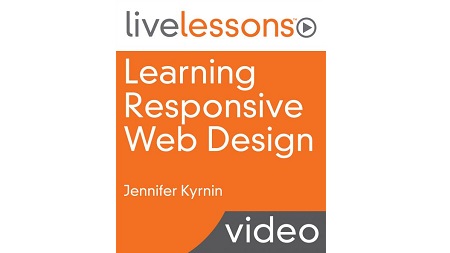
English | MP4 | AVC 1280×720 | AAC 44KHz 2ch | 4h 33m | 1.48 GB
A quick, easy-to-understand video course for beginners on the fundamentals of responsive web design
Learning Responsive Web Design LiveLessons provides web designers and developers with a practical introduction to responsive web design, which is used to create websites that work across many different types of devices from small screen cell phones to large- and multi-screen monitors.
Jennifer Kyrnin is a working web designer and has been teaching and writing about web design, HTML, and web development since 1995. She is a freelance web designer and author, writing regularly for several websites on the Internet. She also teaches and writes about web design, HTML, CSS, JavaScript, PHP, Bootstrap, and XML and is the author of five books related to the Internet and web design.
You Will Learn How To:
- Create effective and reliable responsive designs with CSS3, HTML5, and JavaScript
- Use progressive enhancement to consistently provide the right content while making the most of each device and browser
- Establish breakpoints and write CSS media queries to respond appropriately to each user agent
- Choose the right layout and wireframing approach for your site
- Use web fonts to control typography and choose sizes that look good on any device
- Master three ways to make tables responsive
- Build responsive forms using the latest HTML5 tags and attributes
- Implement responsive navigation patterns that users understand intuitively
- Test for responsiveness and performance
- Use Responsive Design + Server Side Components (RESS) to optimize performance
Table of Contents
01 Learning Responsive Web Design – Introduction
02 Learning objectives
03 1.1 Learn What Responsive Web Design Is
04 1.2 Learn the History of Responsive Web Design or RWD
05 1.3 Understand the Alternatives to RWD
06 1.4 Why RWD is the Best Choice for Modern Web Development
07 1.5 Understand How RWD Helps Design for Different Situations
08 Summary
09 Learning objectives
10 2.1 Understand the Basics of HTML
11 2.2 Review JavaScript Basics
12 2.3 Get Started with Cascading Style Sheets
13 Summary
14 Learning objectives
15 3.1 Get Started With Media Queries
16 3.2 How to Write Media Query Expressions
17 Summary
18 Learning objectives
19 4.1 Understand BreakPoints
20 4.2 How to Define Breakpoints
21 4.3 Optimal Breakpoints
22 4.4 My Favorite Breakpoints
23 Summary
24 Learning objectives
25 5.1 Understand Responsive Web Layouts
26 5.2 Types of Layouts
27 5.3 Using Columns in Responsive Layouts
28 5.4 Using Tables for Web Layouts—Pros and Cons
29 Summary
30 Learning objectives
31 6.1 The Importance of Responsive Navigation
32 6.2 How to Make Mobile-Friendly Navigation
33 6.3 Pros and Cons of Standard RWD Navigation Patterns
34 Summary
35 Learning objectives
36 7.1 How to Make Images Responsive
37 7.2 Keep the Download Speeds Fast
38 7.3 Use Retina-Ready Images
39 Summary
40 Learning objectives
41 8.1 How to Make Video Responsive
42 8.2 Make YouTube Videos Responsive
43 8.3 Make a Video Background
44 Summary
45 Learning objectives
46 9.1 Problems With Tables on Small Devices
47 9.2 How to Make Tables Responsive
48 9.3 Layout Tables Are Valid
49 Summary
50 Learning objectives
51 10.1 Use Modern HTML
52 10.2 Make Web Forms Usable
53 10.3 Build a Responsive Form
54 Summary
55 Learning objectives
56 11.1 Test in Your Favorite Browser, but Don’t Stop There
57 11.2 How to Use Google Developer Tools for Testing
58 11.3 Use Devices, if You Can
59 11.4 How to Test When You Don’t Have the Devices
60 Summary
61 Learning objectives
62 12.1 Make the Best Site You Can for the Most People
63 12.2 Avoid the Common RWD Problems and Pitfalls
64 Summary
65 Learning Responsive Web Design – Summary
Resolve the captcha to access the links!